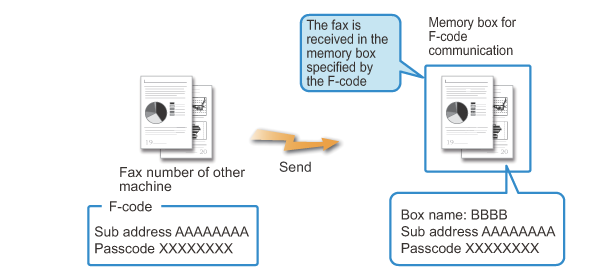F-CODE COMMUNICATION
Overview
This function allows the machine to communicate with another F-code support machine.
It enables exchange of confidential documents (confidential communication), retrieval (polling) and distribution (polling memory) of information, distribution of information to multiple destinations (relay broadcast transmission) with other machines that support F-code communication. An F-code* is specified in each communication, enabling a higher level of security.


- An F-code consists of a sub-address and passcode, and cannot be longer than 20 digits.
- The ITU-T is a United Nations organization that establishes communications standards. It is a department of the International Telecommunication Union (ITU), which coordinates global telecommunications networks and services.
* F-code is a communication function based on the G3 standard of the ITU-T.
How F-codes work
A fax that is transmitted with an F-code is received in the memory box of F-code communication in the receiving machine specified by the F-code (sub-address and passcode). If the F-code does not match between the sender and receiver, no fax is received.
The products of other manufacturers may use different terms for "sub-address" and "passcode". If you need to contact the operator of another machine regarding sub-addresses and passcodes, refer to the terms used by the ITU-T in the table below.
| The machine | ITU-T | ||
|---|---|---|---|
| F-code polling memory box | F-code confidential box | F-code relay broadcasting function | |
| Sub address | SEP | SUB | SUB |
| Passcode | PWD | SID | SID |